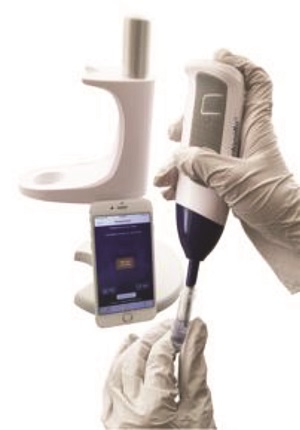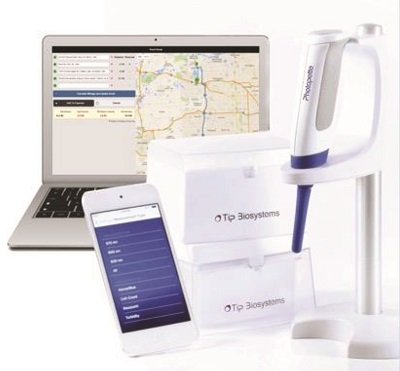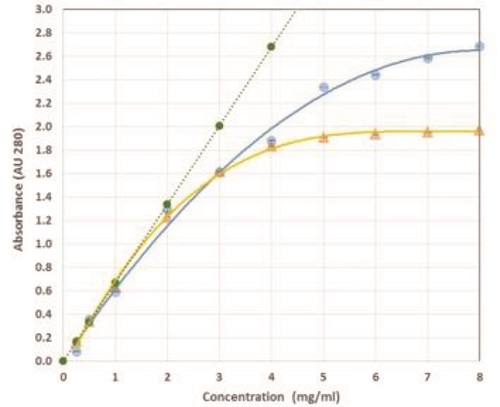Featured Article

Spectrophotometric characterization and analysis is essential across myriad applications in the life sciences, environmental, pharmaceutical, diagnostics, chemical, and food and beverage industries. While spectrophotometers are important laboratory tools used to detect and identify chemical compounds in liquid samples, they are typically bulky and expensive benchtop machines that take up valuable laboratory space and require additional hardware to analyze the collected data. The need for a low-cost, portable spectrophotometer that offers the high performance and seamless integration with cloud, web, and mobile computing in the modern laboratory led to the development of the Photopette handheld spectrophotometer from Tip Biosystems (Singapore).
The Photopette is a handheld, fixed-wavelength spectrophotometer packed into an ergonomic housing that weighs just over 6 ounces. It has a modular design that can be configured with up to six wavelengths from UV to the visible spectrum, offering flexibility to conduct a diverse range of measurements and analyses. The device works in combination with the CuveTip disposable measurement tip (Figure 1), with the entire instrument wirelessly controlled by a mobile device app (Figure 2).
 Figure 1 – The disposable, plastic CuveTip replaces the classical cuvette, fully integrating into the Photopette to enable fast and easy measurement.
Figure 1 – The disposable, plastic CuveTip replaces the classical cuvette, fully integrating into the Photopette to enable fast and easy measurement. Figure 2 – Photopette app.
Figure 2 – Photopette app.The CuveTip replaces traditional sample transfer into a cuvette. It has a self-filling cavity that draws in liquid via capillary forces when immersed in the sample solution. The Photopette with CuveTip completely reverses the traditional spectrophotometric workflow. Instead of bringing the sample to the spectrophotometer, the Photopette comes to the sample; rather than filling the sample into a cuvette, the CuveTip is directly immersed into the sample. As a result, analysis time is greatly reduced; processes that typically take up to an hour in a benchtop spectrophotometer can be performed in seconds with the Photopette. Not only is sample transfer and measurement time saved, but less material is needed with no additional loss in transport, considerably reducing the footprint of the overall analysis and allowing access to sample amounts too small to measure accurately with benchtop machines.
The Photopette app is available for iOS and Android. With every measurement taken, the app records the GPS position, date/time, userentered notes, and pictures, which are synced and stored in real time and linked to the respective absorbance data. Once collected, all data can be exported via e-mail or uploaded onto the cloud for immediate access from anywhere. Data can be also exported in a format that allows Google Map overlay; this is useful for environmental studies and data visualization. The intuitive, user-friendly application can be used by both casual users and professional scientists to perform high-quality, instantaneous spectrophotometric measurements.
Due to the simple modular design, the Photopette can be easily tailored to any requirement. Models include the Photopette–Custom and Photopette–OEM.
Applications
The Photopette is well-suited for quick spectrophotometric measurements anywhere, from the lab bench to the cell culture hood, and the production plant to the field. The following applications demonstrate its versatility.
Direct cell counting
Many cell culture experiments require accurate counting of cell numbers, often for plating cells at a particular density, calculating cell proliferation rates, or determining the best time for cell harvesting. Live cell counting measurements are typically performed with hemocytometers or Coulter counters, but these systems can be tedious, time consuming, and higher in cost.
Optical methods offer a low-cost alternative. Rather than measuring individual cells, these methods measure the optical density of the cell suspensions. Since cells absorb and scatter light at different wavelengths, measuring the turbidity for a cell suspension at a given wavelength provides an accurate measurement of the cell count.
Figure 3 shows use of the Photopette to determine cell count. Photopette Bio or Cell at 600 nm is used to quantify the cell number of HeLa cells in cell cultures. By using a fresh, sterile CuveTip, measurements are performed directly in the cell culture flask within the hood.
The figure depicts a calibration curve for the HeLa cell count as a function of absorbance at 600 nm. A dynamic range from 3 × 103 to 6 × 106 cells per milliliter was obtained. After calibrating the Photopette once for a given cell type, cell count measurements can be performed immediately and within seconds.
 Figure 3 – Calibration curve at 600 nm for determination of cell count in test samples.
Figure 3 – Calibration curve at 600 nm for determination of cell count in test samples.Direct Protein A280 method
Protein concentration measurements in aqueous solutions are a standard daily procedure in many areas of research. The Photopette can directly analyze a purified protein sample by measuring the optical absorbance at a wavelength of 280 nm (Protein A280 method) without requiring sample preparation or additional reagents.
The Photopette Bio was used for the quantitative measurement of protein concentrations by measuring the UV absorbance at 280 nm (Figure 4). A plot of a standard curve for bovine serum albumin (BSA) absorbance at 280 nm is shown for the Photopette (blue solid line) and a conventional spectrophotometer using a 10-mm cuvette (orange solid line). The theoretical BSA absorbance is represented by the green dotted line.
 Figure 4 – Absorbance measurements on BSA samples at 280 nm using the Photopette (blue) and a conventional spectrometer (orange) compared to the theoretical absorbance (green).
Figure 4 – Absorbance measurements on BSA samples at 280 nm using the Photopette (blue) and a conventional spectrometer (orange) compared to the theoretical absorbance (green).A linear relationship can be observed up to 2 mg/mL protein concentration for both the Photopette and the conventional spectrophotometer. By using the calibration curve for the Photopette, concentrations of up to ~8 mg/mL can be measured without dilution. In comparison, the measurement range of the conventional spectrophotometer was limited to about ~5 mg/mL, where the calibration curve begins to level off.
Direct turbidity measurement
Turbidity measurement of an aqueous solution is a common procedure used to measure water quality, yeast cells in breweries, and concentrations of suspended particles, bacteria, and mud. Turbidity can be defined as the change in transparency of a solution as a function of the concentration of suspended and dissolved material, caused by scattering, refraction, and attenuation of incident light; the higher the intensity of the scattered or attenuated light, the higher the turbidity.
Turbidimeters are calibrated with a formazin standard suspension and are measured in water treatment standard units of formazin attenuation units (FAUs). Formazin standards of 4000 FAU (equivalent to 4000 nephelometric turbidity units [NTUs]) are typically used to calibrate the turbidimeter and can be obtained from various suppliers. FAUs measure the change in transmission for an incident light source of a particular wavelength or wavelength range after passing through a sample at a 180º angle due to the sample’s turbidity. The ISO 7027 standard, “Water Quality—Determination of Turbidity,” specifies a measurement wavelength of 830–890 nm. The Photopette Turbidity uses an 850-nm LED with a bandwidth of about 20 nm as a light source, in compliance with ISO 7027. A 4000-FAU standard serial dilution was performed and measurements are plotted in Figure 5 up to 2000 FAUs.
 Figure 5 – Standard curve at 850 nm for turbidity standard using Photopette.
Figure 5 – Standard curve at 850 nm for turbidity standard using Photopette.A linear regression was performed on the data. The equation of the standard curve in Figure 5 has an R-squared value of 0.9982. The slope obtained was 0.00075 AU/NTU or 0.75 AU/kNTU. (Note that suspended particles in a turbid solution tend to settle rapidly, causing a nonuniform density in the solution. Therefore, it is important to measure immediately after agitation to achieve accurate readings.)
Summary
The Photopette provides fast and convenient spectrophotometric measurements at the wet bench, in the cell culture hood, or in the field. Performance is comparable to other fixed-wavelength benchtop spectrophotometers. With the addition of the sterile, single-use CuveTip, which does not require sample dilution or transfer, measurements can be taken instantly and reliably. Photopette has the additional benefit of ambient light correction and a large dynamic range (up to AU 3). The easy-to-use device features an intuitive app that runs on any iOS/Android phone or tablet. More applications are available at www.tipbiosystems.com.
Dieter Trau, Ph.D., is founder, Tip Biosystems Pte. Ltd., 21 Bukit Batok Crescent, #14-79 WCEGA Tower, Singapore 658065; tel.: +65 6914 7600, e-mail: [email protected];www.tipbiosystems.com